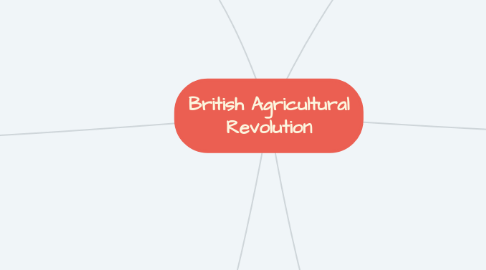
1. Four Field Crop Rotation
1.1. Was introduced to Britain from the Netherlands.
1.1.1. They introduced turnips and clover to replace the fallow year.
1.1.2. Clover was an ideal fodder crop. It improved grain yields in the following year increasing cereal and livestock production.
1.2. In 1730 by Viscount Charles "Turnip" Townshend.
1.2.1. The regular planting of legumes slowly increased the fertility of croplands.
2. Mechanization
2.1. Improved farming efficiency.
2.1.1. Jethro Tull
2.1.1.1. 1701
2.1.1.2. The first advancements in agricultural technology with his seed drill
2.1.1.2.1. A mechanical seeder which distributed seeds efficiently across a plot of land
2.1.2. Joseph Foljambe's Rotherham
2.1.2.1. 1730.
2.1.2.2. A plough.
2.1.2.2.1. Was the first iron plough to have any commercial success,
2.1.2.2.2. Combining a number of technological innovations in its design.
2.1.2.2.3. It was lighter than traditional ploughs.
2.1.2.3. It remained in use in Britain until the development of the tractor
2.1.3. Andrew Meikle's
2.1.3.1. 1786.
2.1.3.2. Threshing machine
2.1.3.2.1. Led to the 1830 agricultural rebellion of Captain Swing.
2.2. Reduced costs, not least by making many workers redundant.
3. WHAT IS IT?
3.1. - Series of developments in agricultural practices. - Which resulted in a massive increase in productivity and agricultural output.
4. Selective Breeding
4.1. England
4.2. Robert Bakewell and Thomas Coke
4.2.1. They introduced selective.
4.2.1.1. BREEDING
4.2.1.1.1. Mating together two animals with particularly desirable characteristics.
4.2.1.2. INBREEDING
4.2.1.2.1. Reduce genetic diversity in desirable animals.
4.2.2. Programs as methods for producing bigger and more profitable livestock.
4.2.3. In the mid 18th century.
5. Enclosure
5.1. The 12th century.
5.2. Open fields in Britain were being in closed into individually owned fields.
5.2.1. This led to villagers.
5.2.1.1. Losing their land.
5.2.1.2. Grazing rights.
5.2.1.3. Many unemployed.
5.2.2. In the 16th and 17th centuries, the practice of in closure was denounced by the Church.
5.3. The 18th century required large, enclosed fields in order to be workable.
5.3.1. Culminating finally in the General Inclosure Act of 1801.

